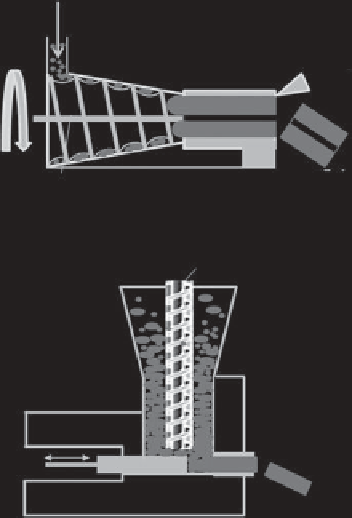Environmental Engineering Reference
In-Depth Information
Cutting
Die
Briquette
Screw (conical)
Screw
Hopper
Moving piston
Briquette
FIGURE 8.4
Some technologies for briquette production; screw press (top) and piston press
(bottom).
that is released by the extrusion process is cut into well-shaped chunks, the briquettes.
As briquettes are mainly applied in domestic energy supply and not so much indus-
trially, we do not go into more details here.
8.9.2 Pelletizing
Pelletizing technology was introduced in 1880 for the purpose of producing cattle
feed; since then, it increasingly shifted to fuel production for the (domestic) energy
market, and now, pelletizing for biofuel production is a large-scale commercial
activity. Pellets have become a rather common fuel type for domestic and industrial
firing. In Europe, the two leading countries in this business are Finland and Sweden.
Pellet production exceeded 1930 kt in 2007 (Hirsmark, 2002; Sikanen et al., 2009;
Uslu et al., 2008). In 2008, the top four producers (in quantity) globally were the
United States (4.1 Mt), Germany (3 Mt), Sweden (2.2 Mt), and Canada (2.1 Mt)
(tinyurl.com/l9y3omo).
The major aim of the pelletizing process is to increase the energy density of the
biomass and to achieve a considerably smaller specific volume, so that the pelletized
biomass is more efficient in terms of storage, shipping, and converting it to heat and
power or chemicals. The overall process comprises of pretreatment (size reduction,









Search WWH ::

Custom Search